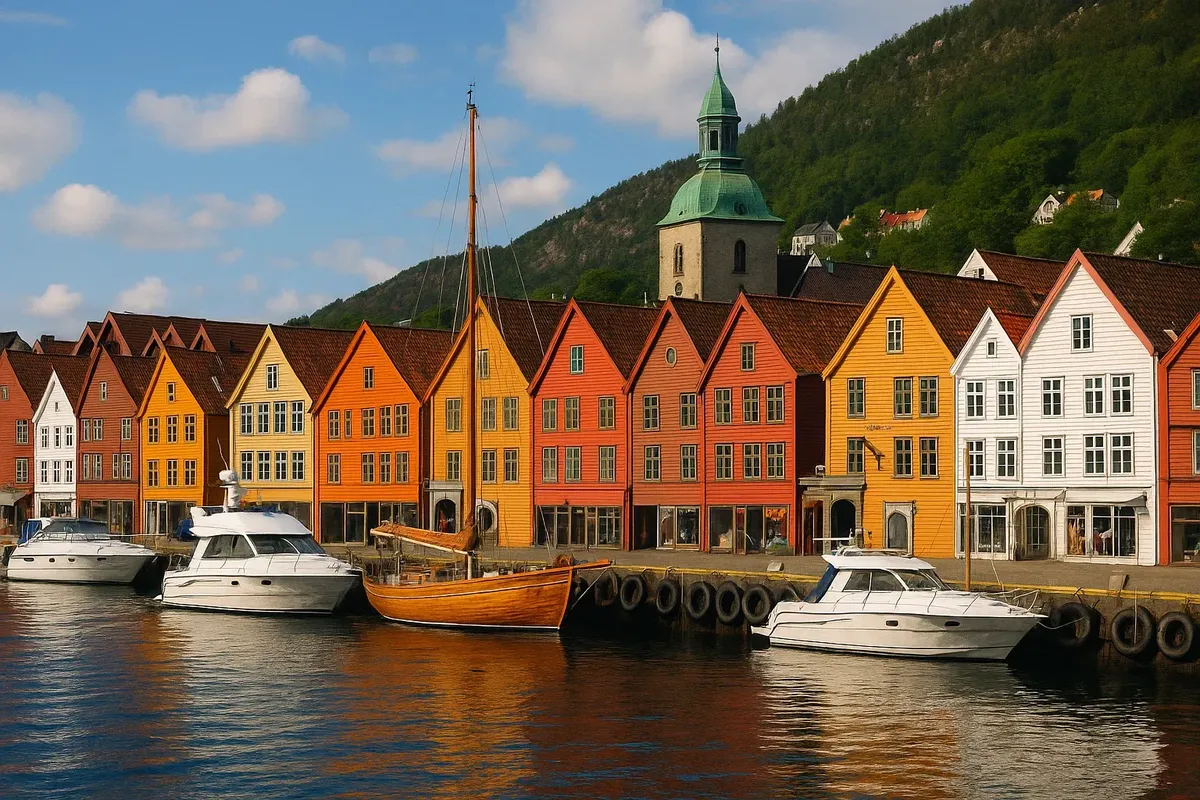💡 How much does it cost to live in Norway: comparing Oslo, Bergen, Trondheim and Tromsø in 2025
Norway is such a lovely place to live, isn't it? It regularly ranks in the top five countries in the world in terms of quality of life. But – and this is a big but – it also ranks in the top five most expensive countries. The price you pay depends on things like the city you live in, the climate, what kind of subsidies are available and your lifestyle. We picked four of our favourite places to visit in Norway – the capital Oslo, the rainy coastal city of Bergen, the student city of Trondheim, and the Arctic city of Tromsø – and compared them based on ten different things you might spend money on.
🏠 How much does it cost to rent a one-room apartment in the centre?
Oslo is a beautiful city, but it does cost a lot of money. You could pay around 16,950 NOK a month for a one-room apartment in the Majorstuen or Grünerløkka neighbourhoods. In the lovely Bergen, you could get a similar size apartment in Bryggen for 13,100 NOK. Trondheim (student town) asks for 13,700 NOK, but often includes furniture, which is a bonus! In the beautiful Arctic Tromsø, the cost of living is 13,600 NOK, which is pretty reasonable. The northern bonus to salaries is a nice perk, and it helps to balance out the energy costs. The reason for the difference is really interesting. In Oslo, studios get snapped up within 24 hours of being advertised, while in Bergen, the market is oversaturated with offers from the university and shipping companies.

🚉 And what if you'd like to live a little further out?
Hey, just so you know, if you're thinking of moving 10–20 minutes away from the T-bane or Bybanen, you'll save money! Oslo is now at 14,180 NOK, Bergen at 9,700 NOK, Trondheim at 10,600 NOK, and Tromsø at 12,300 NOK. You'll really notice the savings in Bergen (26% less than in the centre), because the city stretches along the coast, and the Bybanen tram takes just 30 minutes from Fyllingsdalen to Bryggen. In Oslo and Tromsø, the distance makes a big difference to the cost of living – prices are much lower in the north.

🔌 And how much do utilities cost?
I'm so glad to tell you that the average bill for electricity, water and rubbish collection (85 m², 2 people) is as follows: Hey, just so you know, the prices are 2,170 NOK in Oslo, 2,250 NOK in Bergen, 2,750 NOK in Trondheim and around 2,470 NOK in Tromsø. I'd love to know why the north isn't leading the way. I'm delighted to tell you that, from 2023, the northern counties of Troms and Finnmark will be exempt from 25% VAT on electricity. And, even better, from October 2025, the government programme 'Norway Price' will start, offering a fixed rate of 0.40 NOK/kWh up to 5,000 kWh. Trondheim is a little cooler, but unfortunately there are no tax breaks.
🚌 I was wondering if you could tell me how much a monthly pass costs?
In Oslo, for example, a 30-day Ruter 'Zone 1' pass will set you back just 985 NOK. In Bergen (Skyss, Zone 1), it'll be just 950 NOK from February 2025, which is 35 kroner cheaper than in the capital. Trondheim (AtB, 1 zone) — 926 NOK. In Tromsø, there's a regional Troms Billett: 30 days 890 NOK (students — 445 NOK). Hey, just so you know, all of our passes include night buses! And for our young ones, schoolchildren and students, we've got some great deals for you. If you're in Oslo, you can get an amazing 40% discount, or if you're in Trondheim, you can grab a special Youth Ticket for just NOK 555!
🥖 Grocery basket: where is bread, milk and fruit cheapest?
Expatistan tells us that a litre of milk costs 21-23 NOK in Oslo, 20 NOK in Bergen, 19 NOK in Trondheim and 22 NOK in Tromsø. A 500g loaf of bread will set you back NOK 32 in Oslo, NOK 29 in Bergen, NOK 28 in Trondheim and NOK 30 in Tromsø. Fruit is a bit more expensive in the north, isn't it? Bananas cost 15 NOK in Trondheim but 18 NOK in Tromsø, all because of the logistics. And finally, my dear friends, here's what I want to share with you: Trondheim is the perfect place for students, while Oslo has some great discount stores.
🍽 I know it's a bit early to start thinking about what you're going to wear, but have you thought about where you're going to eat? I'm sure you're not going to want to spend too much, are you?
I totally get it, the average bill in Oslo (two courses + dessert + beer x2) is 1,200–1,400 NOK. In Bergen, the price drops to 1,050–1,250 NOK; seafood is cheaper 'from the pier'. In Trondheim, you can get dinner in a student bar for 950–1,100 NOK, while in Tromsø, tourist demand raises the bill to 1,300 NOK (especially in winter during the 'aurora season'). Here's a handy tip: if you go for lunch (11:00–14:00) you'll get 25–30% off the evening menu.
💼 Average salary and housing affordability index
On average, people in Norway earn 59,370 NOK a month (2024), which is about 43,800 NOK after tax. In Oslo, the IT sector pays a median salary of 48-50 thousand net; in Bergen — 44 thousand, Trondheim – 42,000, Tromsø (fishing and scientific capital) – 45,000. The rent-to-income index is the ratio of the rent for a one-bedroom apartment in the city centre to the person's net income. Oslo 35%, Bergen 30%, Trondheim 32%, Tromsø 30%. In other words, people in the capital pay more, but housing costs are much higher.
🎓 How much money do you need to live on as a student? Is it realistic to live on 12,000 Norwegian kroner?
In Trondheim, Lånekassen provides a scholarship/loan of 13,690 NOK/month (2025), and the dormitory at the Moholt campus costs from 4,700 NOK. Add NOK 926 for a Youth travel card, NOK 2,000 for food if you cook for yourself and NOK 1,000 for textbooks, and you get ~NOK 8,700, which is within the limit. In Oslo, even with the cheap Sogn student housing (5,200 NOK), the total cost is 12,500 NOK. Bergen is similar, and Tromsø is more expensive (dormitory 5,400 NOK + heating).
👨👩👧👦 A family of four: what is a 'comfortable' monthly budget?
Numbeo estimates the basic expenses (not including rent) for a family of 2+2: Oslo — 43,800 NOK, Bergen — 41,200 NOK, Trondheim — 40,300 NOK, Tromsø — 42,200 NOK. If we look at how much a three-bedroom apartment in the city centre costs to rent, we can see that: Oslo — 64,800 NOK, Bergen — 61,600 NOK, Trondheim — 62,500 NOK, Tromsø — 63,000 NOK. The 'Family cap' for kindergartens means that the payment is limited to NOK 3,262 per month. This means that kindergarten does not 'break the budget', but winter utilities can.
⚖ How do taxes and subsidies affect the situation?
Income tax is the same (it is progressive, at 22% + trinnskatt), but the VAT on electricity has been abolished in Tromsø/Finnmark, and the new Norway Price programme will reduce the price per kilowatt hour to NOK 0.40 from October 2025. This will mean that people living in the north will have NOK 300-500 less to spend on their winter bills each month. In the south, you can get money back through Enova grants (heat pumps, solar panels) — up to NOK 25,000. In Bergen and Trondheim, local authorities will pay up to 100% of kindergarten costs for families who earn less than NOK 600,000 a year. This means that the 'expensive' north is partially offset by tax breaks.

Norway is not usually thought of as being cheap, but it still offers good value for money. Oslo has the highest salaries, but the highest living costs; Bergen has a mild climate and fast trams; Trondheim is a student city with cheap travel passes; and Tromsø combines the excitement of the Arctic with cheap electricity. If you know where it is expensive and where subsidies are hidden, you can choose a city that suits your lifestyle or adjust your travel budget. The most important thing is to count not only the kroner, but also the experiences: the northern lights, concerts in wooden cathedrals and the thrill of Norwegian nature are often worth the money you pay for a comfortable life.




2 comments
Log in to leave a comment
Hvilken by vil dere anbefale for folk som vil ha en god balanse mellom pris og livskvalitet? 🤔
Jeg visste at Oslos leiligheter går unna på 24 timer, men jeg lurte på hvorfor markedet i Bergen har så mye mer å velge mellom – universiteter og rederier forklarer jo en del. Det er virkelig smart tips å bo litt lenger fra metro eller trikk – sparer man opptil 26 % i Bergen, er det jo verdt turen! 😄